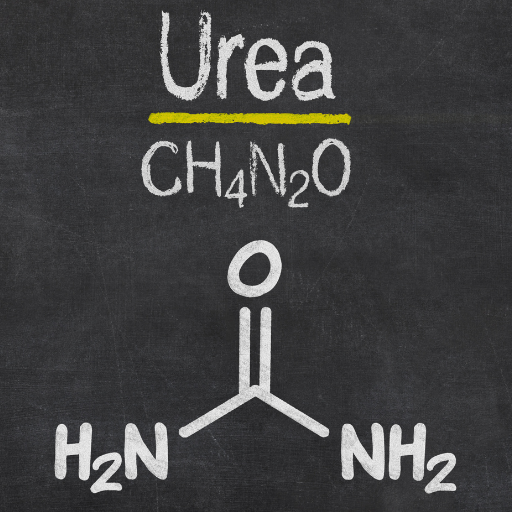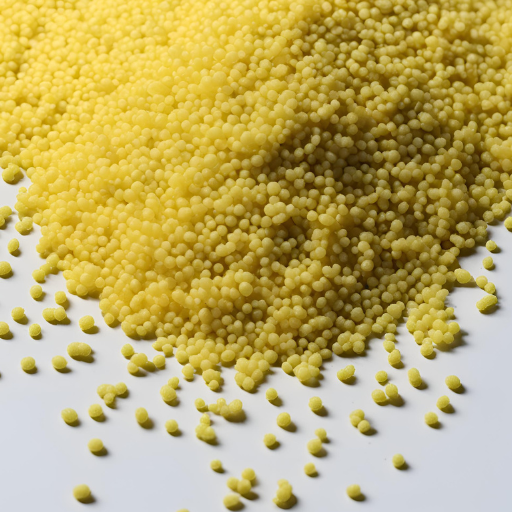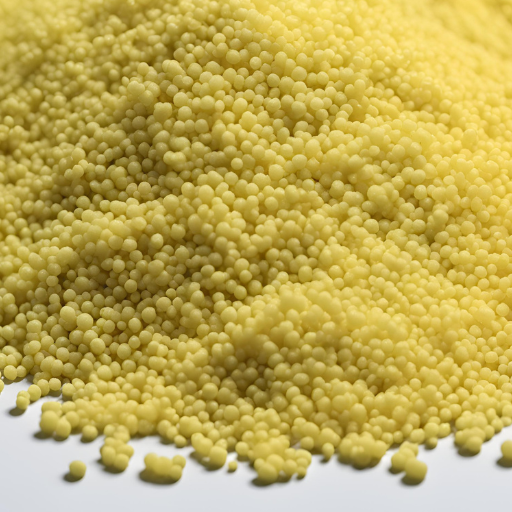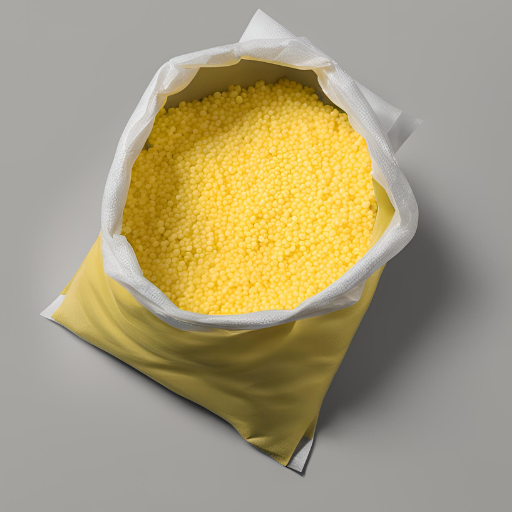Effective nutrient usage together with maximum crop growth is highly crucial in modern farming practices to satisfy the global food demand while ensuring sustainability. One of the inventive approaches that have been developed to combat these issues is called sulphur Coated Urea (SCU) fertilizer technology. By combining sulphur and nitrogen, this technology ensures slow release of nutrients that benefit plant growth while minimizing environmental effects. We will understand how SCU differs from traditional fertilizers by studying the functions of these nutrients and the science behind controlled-release fertilizers. Improved Nitrogen Use Efficiency, reduced leaching and uniform plant health are some of the ways in which SCU can be harnessed as a tool for modern agriculture. This article discusses importance, functionality, benefits and application strategies of SCU; it provides insights on how farmers can achieve high efficiency and crop yield using this advanced fertilizer technology.
What Is Sulphur Coated Urea and Its Importance in Agriculture?

SCU is a controlled-release fertilizer characterized by the encasement of granules made from urea with sulphur to check the release of nitrogen into the soil. In order for plants to obtain nutrients over an extended period as well as have better nutrient uptake and minimize leaching, this method utilizes slow-releasing mechanism. sulphur in the coating not only delays release but also provides a vital secondary element that encourages enzyme activity and chlorophyll synthesis in plants. The importance of SCU in agriculture is its ability to enhance crop performance, increase yield and promote sustainable farming through minimizing environmental consequences and improving nutrient management
Understanding Sulphur Coated Urea (SCU) Fertilizer
A sulphur Coated Urea (SCU) fertilizer is one that has a coating of sulphur on the particles of urea, which subsequently regulates nitrogen release. The regulated nitrogen release matches plant nutrient uptake requirements and minimizes leaching and volatilization losses. N2O emissions are reduced by using SCU, thereby improving nitrogen use efficiency and enabling uniform plant growth as well as reducing the adverse environmental impacts associated with traditional fertilizers. Besides contributing to soil health through enzyme function promotion and production of chlorophyll among other things, sulphur in the coating is also essential for overall plant vigor due to its role in providing an important nutrient.
Importance of Nitrogen and Sulphur in Plant Growth
Sulphur and nitrogen are essential elements for plants’ existence. In fact, sulphur plays a vital role in photosynthesis since it is required for chlorophyll formation besides synthesizing some amino acids as well as enzymes necessary for metabolism within plant tissues. Usually, technical limits for plant’s sulphur requirement are between 15 to 30 kg/ha based on crop species or soil conditions.
Nitrogen forms part of proteins’ building blocks called amino acids making them a major constituent especially during development of new tissues which leads to increase in total biomass. Depending upon stage at which crops species grow these amounts can range from 50-200 kg/ha but have been shown to change quickly over time. To prevent environmental loss related issues, a controlled release method of releasing nitrogen from SCU ensures continuous supply to plants hence keeping up with protein synthesis process facilitating growth due to its availability without any risk being posed by emission escaping into air space.
Through ensuring that both sulphur and nitrogen are supplied proportionally, SCU fertilizers safeguard crop productivity by increasing nutrient uptake efficiency while at the same time minimizing negative ecological effects leading into sustainable agricultural practices.
Advantages of Slow-Releasing Fertilizers like SCU
Slow-release fertilizers like SCU are advantageous in many ways when it comes to agricultural practices. The first benefit is increased plant nutrient uptake efficiency. In this case, the nutrients are released slowly hence a steady supply that matches the growth requirements of the plants over a long period thereby reducing the chances of nutrient leaching and run-off tremendously. This helps not only in having better crop yields but also reduces environmental concerns caused by use of common fertilizers. Further, slow-release fertilizers help cut down costs and labor related to frequent fertilizer applications. They promote healthier root systems and improve soil fertility by releasing essential nutrients continuously which enhance strong growth and ability for stress tolerance in plants.
How Does Sulphur Coated Urea Work?

Sulphur coating of urea, where sulphur is applied over the granules of urea, acts as a mechanism for controlled release. When such fertilizer is put on the soil, the urea does not dissolve quickly and nitrogen is released gradually. A layer of sulphur serves as a coating that limits the amount of water that gets in contact with urea. After the first stage, water and microbial action from the soil make it undergo slow degradation due to slight moisture content in the soil and naturally occurring environmental processes like weathering and microbial activities. The rate at which sulphur degrades determines how slowly nitrogen will be made available. This feature enables continued availability of nitrogen to plants while reducing losses from leaching or volatilization thus improving nutrient use efficiency thereby promoting sustainable agriculture.
The Science Behind Controlled-Release Fertilizers
Controlled-release fertilizers (CRFs) function on different principles that lengthen nutrient supply to crops. Techniques used in this process include polymer coatings, sulphur coatings as well as biological inhibitors acting as physical barriers to nutrient release depending on factors such as temperature, moisture content among others required for efficient crop uptake without contributing to pollution especially when many applications are needed.
Key technical parameters for CRFs:
- Nutrient Release Rate: Nutrients can become available for uptake by plants within a period varying between few weeks to several months, depending on composition and thickness of coatings.
- Nutrient Content: Main components of these fertilizers are usually nitrogen (N), phosphorous (P), potassium (K) elements found in a balanced ratio along with some other macro/micronutrients.
- Granule Size: Normally, granules range in size from 2 -4mm which influences their release pattern and ease of application.
- Coating Thickness: Duration of nutrient supply directly depends on thickness ranges around 10-50 µm.
These parameters are meticulously designed to synchronize nutrient availability with plant growth stages, enhancing crop performance and sustainability in agricultural practices.
Coating Urea Granules with Molten Sulphur for Slow Release
Slow release fertilizers can be prepared by coating urea granules with molten sulphur. The process of making these fertilizers involves applying heated urea granules on which sulphur is melted to form a solid covering around them. This barrier determines the rate at which nitrogen is released into the soil thus minimizing loss of nitrogen through leaching and volatilization. Upon contact with either water or microorganisms, the sulphurous coating over time decomposes partially, causing the slow release of nitrogen that follows plant nutrient requirements corresponding to needs of growing crops. By adopting this approach, farmers can minimize environmental impacts associated with regular fertilization while improving Nitrogen Use Efficiency (NUE) within their farms because it provides a continuous source of nutrients needed by plants during an extended growth season.
Nutrient Release and Uptake by Plants
It is very important in promoting good health and productivity of plants that nutrients are discharged and absorbed by them. The availability of soil solution nutrients depends on factors such as microbial activity, soil pH, and physical and chemical properties of the soil. Essential nutrients for plants are taken up by roots primarily through root hairs that increase the surface area over which uptake can be made efficient. Passive transport is one mechanism while active transport is another mechanism involved in absorption of nutrients with energy being used to move the latter against the concentration gradient. Equally significant, mycorrhizal associations increase nutrient uptake mainly phosphorus to plants via giving out carbohydrates from it. Inclusion of slow-release fertilizers among other balanced nutrient release strategies can greatly affect crop yields and environmental sustainability.
The Advantages of Using Sulphur Coated Urea Over Traditional Fertilizers

A lot of merits are associated with the use of Sulphur-Coated Urea (SCU) over other conventional fertilizers. To begin with, SCU ensures a slower release rate of nitrogen thereby minimizing nutrient leaching and volatilisation which could lead to environmental degradation. This means that SCU improves NUE by matching the nutrient release to meet the plant requirements throughout its growing period. In this regard, not only is there improved crop yields but also less frequent application of fertilizers hence saving farmers’ time as well as labor costs. On top of this, the presence of Sulphur in SCU helps in addressing sulphur deficiencies in soil which is very important for better protein synthesis and overall healthiness of plants. On the contrary, conventional fertilizers often result into a rapid nutrient release that results in wastage plus potential runoff and GHG emissions damage to environment while causing no significant impacts on climate change. It can be concluded therefore that SCU is more sustainable and efficient than traditional fertilizers for agricultural practices.
Improving Nitrogen Use Efficiency in Crops
Improving nitrogen use efficiency (NUE) in crops is paramount for sustainable agriculture. According to the top sources on the subject, several strategies can be employed to enhance NUE.
- Split Nitrogen Applications: Instead of applying all nitrogen at once, dividing it into smaller doses during key growth stages optimizes uptake. For example, applying 30% at planting, 50% during mid-season, and the remaining 20% close to flowering ensures synchronized nutrient availability with crop demand.
- Use of Controlled-Release Fertilizers: Fertilizers like sulphur-coated urea (SCU) provide a steady nitrogen supply and reduce losses through leaching and volatilization. Studies indicate an increase in NUE by up to 25% with SCU, resulting in better crop yields.
- Adopting Precision Farming Techniques: Utilizing GPS technology, soil sensors, and drones, precision farming tailors nutrient applications to specific field conditions. For instance, variable rate technology (VRT) adjusts fertilizer amounts based on real-time data, leading to a potential 20% increase in NUE.
- Integrating Leguminous Cover Crops: Cover crops such as clover and beans fix atmospheric nitrogen, enhancing soil fertility organically. This practice can increase soil nitrogen content by 25-50 kg/ha, which is gradually released for succeeding crops, thus improving NUE.
- Optimizing Irrigation Practices: Efficient water management through practices like drip irrigation ensures nitrogen is available to crops when needed, reducing the risk of nitrogen loss through runoff and deep percolation. For example, drip irrigation combined with fertigation can enhance NUE by up to 40%.
Technical parameters:
- Nitrogen application timing: Early growth (30%), Mid-season (50%), Flowering (20%).
- Nitrogen use efficiency enhancement with controlled-release fertilizers: Up to 25% increase.
- Increase in NUE with precision farming technologies: Around 20%.
- Soil nitrogen content improvement with leguminous cover crops: 25-50 kg/ha.
- NUE improvement with optimized irrigation: Up to 40%.
These strategies collectively ensure better synchronization of nitrogen availability with crop needs, reduce environmental impacts, and improve overall agricultural productivity.
Reducing Leaching and Environmental Impact
Leaching of nitrogen is a significant concern in agricultural practices, particularly because it leads to environmental pollution and inefficient use of fertilizers. To address this, several strategies have been identified from leading sources.
To reduce leaching, the strategic use of cover crops is highly recommended. According to the University of New Hampshire, cover crops can trap excess nitrogen and keep it within the soil profile, reducing the amount lost to leaching by as much as 40%. Additionally, the use of controlled-release fertilizers, as explained by Michigan State University, can provide a steady supply of nitrogen that matches crop uptake, decreasing the risk of leaching by up to 30%. Incorporating buffer strips as outlined by Iowa State University also offers an effective approach; these vegetative areas between croplands and water bodies can intercept and absorb runoff, reducing nitrogen leaching into waterways by up to 50%.
Technical parameters:
- Reduction in nitrogen loss by cover crops: Up to 40%.
- Leaching reduction with controlled-release fertilizers: Up to 30%.
- Effectiveness of buffer strips in reducing leaching: Up to 50%.
Implementing these measures not only minimizes environmental impact but also enhances nitrogen use efficiency, paving the way for more sustainable and productive farming practices.
Application Tips for Sulphur Coated Urea in Agriculture

Sulphur-coated urea (SCU) is a type of controlled-release fertilizer that particularly works well in improving nitrogen use efficiency and nutrient losses reduction. To optimize its application in agriculture, it is essential to follow a few key steps.
Firstly, consider incorporating SCU at the time of planting or during early stages of crop growth to match nutrient release with plant uptake. Clemson Cooperative Extension suggests distributing SCU across the field uniformly as possible to ensure evenness. Secondly, SCU should be applied on the basis of soil tests and crop requirements to avoid under- or over-fertilization. According to Crop Nutrition, it’s beneficial to integrate SCU into a broader fertilization plan that includes other essential nutrients like phosphorus and potassium. Finally, adjust the application rates depending on the specific crop and local environmental conditions. The University of Florida IFAS Extension recommends considering characteristics like soil type, weather patterns, irrigation practices for best use of SCUs. These tips will help achieve more efficient nitrogen utilization and sustainable crop production.
Best Practices for Applying SCU in Different Crops
For optimizing the application of sulphur-coated urea (SCU) in different crops it is crucial to tailor this approach to meet the specific needs of each crop type:
Corn: According to Purdue University, corn’s recommended rate for applying SCUs varies between around 150 – 200 pounds per acre depending on its nitrate levels in soil as well as yield targets. Other sources recommend pre-planting or side-dress applications when SCUs are mostly required for corn development procedure from V6 stage through V8 stage especially before active vegetative growth begins. It is also important that distribution be done evenly so that nitrogen volatilizes do not escape in form vapour or water dissolves them away.
Source: Purdue University
Wheat: For wheat, an average rate of applying 100 pounds per acre may be used, as recommended by the University of Arkansas depending on test results and expected yield. Beets should be applied either at planting or during tillering so that nitrogen is available when wheat’s growth peaks. Besides, to meet the crop’s nitrogen requirements at stem elongation stage it may be split applied.
Source: University of Arkansas
Rice: Rice growers are advised to apply SCU at a rate of about 90-120 pounds per acre, according to the International Rice Research Institute (IRRI). The best time for application is before vegetative stage or right after transplanting. This will enable steady release of nitrogen over longer duration corresponding with rice growth cycle thus improving overall use efficiency in respect to nitrogen. Avoid putting these fertilizers when there is a likelihood of flooding which might result in loss through runoffs.
Source: International Rice Research Institute
However, always consider local soil tests and environmental conditions while using this foundation for SCU application so as to modify it suitably for good outcome.
Timing and Rate of SCU Application for Maximum Efficiency
To maximize efficiency in applying SCUs (sulphur-Coated Urea), you need to know the latest research studies and recommendations from leading agronomic institutions on timing and rate.
- Corn: According to agronomic experts, corn has the most appropriate SCU application rate of between 60 and 120 pounds/acre based on soil fertility levels and expected yields. The best time to apply SCU is during planting or early crop growth stages (V4 – V6). This timing ensures steady nitrogen release which is critical for rapid vegetative and reproductive growth periods.
- Wheat: Available literature suggests that wheat requires an SCU application rate of about 90-120 lbs/acre depending on soil test results. Application can be done at planting or in early tillering so that nitrogen is available throughout critical growth phases of the crop, especially during stem elongation. Split applications may also enhance nutrient efficiency and uptake.
- Rice: For rice, recommended rates can range from 70 – 110 lbs/acre of SCU which depend on field specific conditions and yield goals. It should be done just before the vegetative stage or immediately after transplanting. This allows for a longer supply of nitrogen in relation to periods when it is needed by the crops as they grow. Avoid applying during flood prone periods since much will be lost due to runoff.
The optimal SCU application must strike a balance between rate and timing in accordance with key crop growth stages in order to enhance nitrogen use efficiency and overall crop productivity. These recommendations should be tailored to local soils/climate for best outcome.
Blending SCU with Other Nutrients and Fertilizers
Mixing other nutrients and fertilizers with slow-release sulphur coated urea significantly improves nutrient use efficiency and crop performance. However, while combining P & K with S.C.U., one must realize that this particular practice needs accurate assessment of both crop requirements for such nutrients as well as its soil profile regarding these issues. For example, when applied alongside a balanced NPK fertilizer, plants receive all necessary nutritive elements leading to healthier vegetation with higher yields.
Considerations include:
- N-P-K Ratio: While it may vary for different crops, as a rule NPK ratio is 10-20-10 for root vegetables and 18-24-6 for leafy greens. It is important to get the right ratio based on soil test and crop needs so that nutrient uptake will be optimized.
- Application Timing: It is important to match SCU application with P & K use. For example, have in place at planting balanced NPK fertilizers to serve as immediate sources of the main nutrients while SCU will provide continuous nitrogen supply.
- Soil pH and Buffering Capacity: For most crops, maintaining soil pH at about 6.0 – 7.0 would be ideal because this affects availability of nutrients. In acidic soils combining lime with sulphur-coated urea may increase pH levels therefore enhancing nutrient absorption.
- Water Management: The practice of efficient irrigation works together well when slow release fertilizers are being used along other types of fertilizer. Over irrigation does not allow for proper soaking up of the nutrients into the plants since the water will drain away all the applied manure from the farmland.
Following these guidelines and making site-specific adjustments will ensure effective integration of slow-release sulphur coated urea into other fertilizers thereby improving overall crop health and productivity.
Impact of Sulphur Coated Urea on Nitrogen Use and Soil Health

One of the major breakthroughs in nitrogen use efficiency is Sulphur Coated Urea (SCU). For better and longer availability of plant held-nitrogen, it slowly releases the nutrient to plants which reduces any possible ground water pollution due to leaching and hence avoids the risk related with gas volatilization. The controlled released apply best to crop stages hence good N utlisation and uptake. This is because sulphur coating does not only help in providing controlled release of nitrogen but also supplies vital sulphur that plays a significant role in protein synthesis as well as functioning of enzymes within plants. With time, this product can assist in neutralizing soil acidity, improving microbial life and achieving more balanced nutrient composition towards healthy productive soil.
Increasing Nitrogen Use Efficiency through SCU
Nitrogen use will be increased using Sulphur coated urea (SCU) since they have slow release mechanisms releasing nitrates over a long period that aligns well with crop needs across the growing season. Slow-release mechanism prevents nitrogen loss by leaching and volatilization thus leaving more nitrogen available for plant absorption. Inclusion of sulphur increases overall plant health by improving nitrogen metabolism pathways leading to enhanced plant survival. Application of SCU together with other fertilizers increases supply during growth resulting into less environmental damage from excess n application while maximizing produce output possibilities.
The Interaction between SCU, Soil Health, and Nutrient Uptake
Interplay between SCU, soil health and nutrient uptake is important for sustainability purposes especially in agricultural systems. This limits nutrient losses by leaching or volatilization due to reduction on nitrate migration which occurs during rainfall infiltration into soils when it has just been applied. It’s usefulness lies in the fact that when crops are growing so is its total N content especially when the nutrients are used efficiently at every stage.The inclusion of sulphur helps plants synthesize proteins and for enzymes to function. All these advantages result in a balanced and fertile soil ecosystem that ensures efficient nutrient acquisition and maximum agricultural output.
Addressing Leaching and Environmental Concerns through Sulphur Coated Urea
To tackle the concerns of leaching and environmental impacts related to fertilizer use, it is recommended that Sulphur Coated Urea (SCU) be employed in the farming process. Through this SCU has significantly reduced nitrate leaching into groundwater hence reduced water contamination reducing aquatic destruction. This results in lesser volatilization hazard due to something like better N synchronised release with crop needs. Further, nitrogen is gradually released over time by SCU promoting better synchronization with crop nutrient requirements during different growth stages thus limiting potential losses through volatilization as well as more N utilization by plants rather than loss to the environment. Specifically, sulphur inclusion within the formulations of SCU plays an integral part towards improving nitrogen absorption, uptake and overall nutrient use efficiency in plants. Carbon dioxide levels are also lowered when there’s nutrient synchronization that reduces GHG emissions thus making it environmentally friendly and reducing its footprint, making SCU important in sustainable agriculture practices.
Maximizing Urea Efficiency with Sulphur Coating: The Urea Gold Standard

Sulphur coated urea (SCU) increases the efficiency of urea by sulphurizing it, which leads to a prolonged release period of nitrogen. This slow release is in step with plant nutrient needs, thereby greatly enhancing nitrogen uptake and minimizing losses through leaching and volatilization. Thus, SCU allows for longer availability of more N to crops hence supporting continuous growth and high yields. The use of S also acts as a way of improvement in NUE while having effects on vital plant processes such as enzyme activity and protein synthesis. It can thus be said that SCU technology sets the gold standard for efficiency in urea towards sustainable agriculture.
Case Studies: Success Stories in Increasing SCU Yield
One excellent example is a large-scale corn farm located in Iowa where SCU application led to an increase of 15% yield during three growing seasons. The farm also reported less loss of nitrogen due to reduced leaching making the uptake system more efficient and enabling stronger plant growth. Technical parameters showed that the applied SCU has about 90-120 days duration between nitrate release and sulphur coating accounted for approximately 10% of granule weight.
Another success story comes from rice paddy fields in Vietnam whereby farmers noted a 20% increase following shift to SCU use. This particular SCU formular had a time release period of roughly 60-90 days with sulphur making up 9%. Such prudent nutrient management prevented excessive nitrogen from seeping into water systems resulting into directed fertilization for better plants’ health.
In one study on Canadian wheat production, adoption of SCU resulted into an increase in wheat yields by around 18%. Nitrogen was released over such periods as 70-100days depending on the formulation used and contained about 8% sulphur by weight.The controlleddelivery ensured stable nutrients supply which is key at this stage when wheat is growing but also increased its protein content in harvested grains which was an indication of improved nutritional value.
These case studies demonstrate how the SCU has proved to be most effective for large scale farming with significant increase in crop yields and at the same time promoting sustainable agricultural practices.
Strategies for Implementing SCU in Crop Management
It is important to first understand the specific nutrient requirements and life cycle of these crops before effectively implementing SCU in crop management. Take soil samples to determine starting nutrient levels and where deficiencies are. The next step is selecting the right SCU formulation that aligns with plant nutrient demand as well as growth duration. Timing and application methods are key; early season applications release nutrients continuously throughout plant development. Additionally, integrating SCU with other sustainable practices such as crop rotation and cover cropping can improve soil health while also increasing nutrient use efficiency. Monitoring how well crops grow under these conditions allows fine tuning of appropriate cultural practices through observation, thus resulting in maximum yield and sustainability.
The Future of Urea Market: Trends and Predictions Involving SCU
The future of urea market appears to be advancing in a remarkable way, as we observe with the trend and predictions that highly favours Sulphur Coated Urea (SCU) adoption. From some of the industry’s leading thoughts, there is expected to be higher demand for SCU due to its nutrient delivery efficiency and environmental benefits resulting from global sustainable agriculture focus. The technological advancements are also projected to improve SCU manufacture making it more effective and cost-effective. Moreover, government policies, rules and guidelines that seek to minimize greenhouse gas emissions by agriculture will enhance usage of controlled release fertilizers such as SCUs. All-in-all; I have faith that SCU will be instrumental in influencing the urea market into achieving productivity versus sustainability equilibrium in modern farming techniques.
Reference sources
- ScienceDirect – sulphur-Coated Urea Overview
- Source: ScienceDirect
- Summary: This source provides a comprehensive overview of sulphur-coated urea fertilizers, detailing their development and benefits. It discusses the process of coating urea with sulphur, highlighting the slow-release properties of this type of fertilizer.
- Turf Care Supply – Enhanced Efficiency Fertilizers
- Source: Turf Care Supply
- Summary: The article from Turf Care Supply focuses on Enhanced Efficiency Fertilizers, specifically sulphur Coated Urea (SCU). It explains how SCU is produced by coating urea granules with sulphur and wax, emphasizing its effectiveness in providing nutrients to plants over an extended period.
- Industry ARC – sulphur Coated Urea Market Size Report
- Source: Industry ARC
- Summary: This market report analyzes the sulphur Coated Urea market size, forecasting significant growth and reaching a value of US$3.5 billion by 2027. It details the forecasted CAGR and trends within the industry, making it a valuable resource for understanding the market dynamics and potential opportunities related to sulphur-coated urea.
Frequently Asked Questions (FAQs)
Q: What is sulphur-coated urea fertilizer?
A: sulphur-coated urea fertilizer is a type of slow-release fertilizer produced by coating preheated urea granules with molten elemental sulphur. This coating facilitates a gradual release of nitrogen, enhancing the efficient use of urea in crops.
Q: How does sulphur-coated urea improve crop growth?
A: sulphur-coated urea improves crop growth by providing a sustained release of nitrogen, which is essential for plant development. This slow-release fertilizer ensures that plants receive a steady supply of nutrients over time, leading to robust growth and higher yields.
Q: What are the benefits of using sulphur-coated urea compared to regular urea?
A: sulphur-coated urea reduces urea consumption by minimizing nitrogen losses through leaching and volatilization. It enhances nitrogen use efficiency, reduces the environmental impact, and provides longer-lasting nutrient availability, promoting healthier soil and plant growth.
Q: Can sulphur-coated urea be used for turfgrass?
A: Yes, sulphur-coated urea is ideal for turfgrass management. It is a preferred choice in turf care supply because it provides a steady release of nitrogen, leading to uniform growth and maintaining the quality of the turf over time.
Q: How do the properties of sulphur-coated urea affect solubility?
A: The coating of elemental sulphur affects the solubility of the urea particles, creating a slow-release mechanism. This controlled solubility prevents rapid nitrogen release, which helps to maintain soil fertility and reduces the risk of nitrate leaching into groundwater.
Q: How is sulphur-coated urea manufactured?
A: sulphur-coated urea is prepared by coating preheated urea granules with molten elemental sulphur. This process involves heating the urea granules and then applying a sulphur layer, which cools and solidifies, forming the slow-release coating.
Q: What percentage of nitrogen does sulphur-coated urea typically contain?
A: sulphur-coated urea contains about 31%–38% total nitrogen. This high nitrogen content, combined with the slow-release properties, makes it an efficient and economical slow-release fertilizer option for various cropping systems.
Q: Why is sulphur-coated urea considered an economical slow-release fertilizer?
A: sulphur-coated urea is considered an economical slow-release fertilizer because it maximizes nitrogen use efficiency, reducing the frequency and quantity of fertilizer application needed. This reduces both the cost and labor associated with fertilization while providing consistent crop growth benefits.
Q: What are the environmental benefits of using sulphur-coated urea?
A: The use of sulphur-coated urea offers several environmental benefits. It reduces nitrate leaching and nitrogen volatilization, which helps minimize water contamination and greenhouse gas emissions. This makes it a more environmentally friendly option compared to urea fertilizers with higher solubility and quicker nitrogen release.






